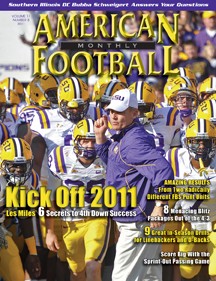Article CategoriesAFM Magazine
|
Punting: Improving Your Net – The most important punting stat – net yards – can be increased by using these successful coverage schemes.by: Curt Block© More from this issue John Lilly has been an assistant to head coach Mark Richt at the University of Georgia for the last four seasons with responsibilities that include the punting unit. Lilly outlined this possible fourth down scenario: “You’ve just been stopped,” Lilly proposed, “and you have to give up the thing you need to put points on the board. You have to sell the team that the punt is our opportunity to make a huge play. When you see a punt returner put his hand up for a fair catch and know that if he muffs it, you have every right to recover the ball. It could be like you’ve just thrown a 50-yard completion. “There’s a lot that can go wrong on the punt team – bad snap, poor protection, bad kick – and maybe a guy breaks it for a touchdown. But you also have games with two great defenses and often it’s the punting game tha....The full article can only be seen by subscribers.
|
|
|||||||
| HOME |
MAGAZINE |
SUBSCRIBE | ONLINE COLUMNISTS | COACHING VIDEOS |
Copyright 2025, AmericanFootballMonthly.com
All Rights Reserved





